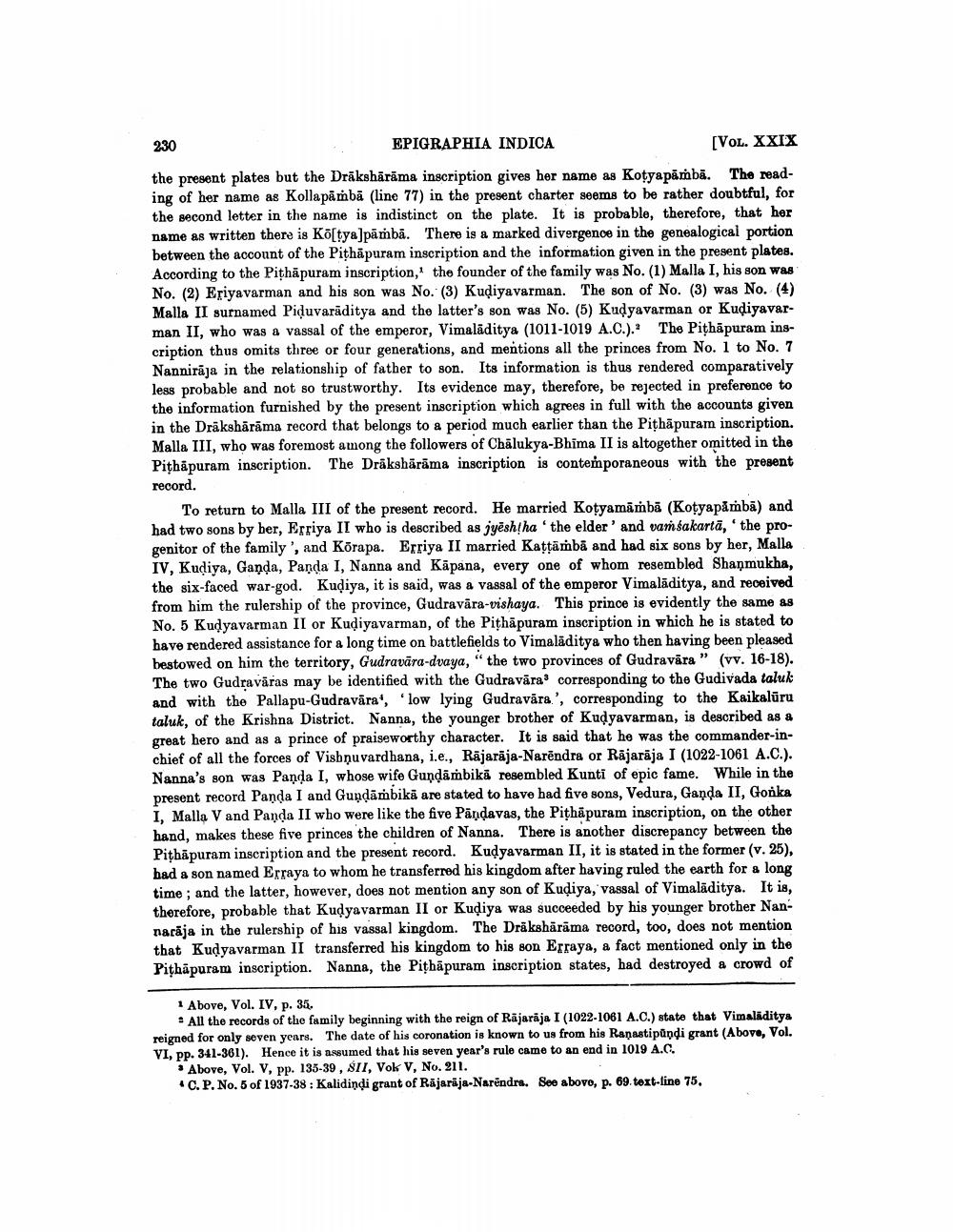________________
230
EPIGRAPHIA INDICA
[VOL. XXIX
the present plates but the Drākshārāma inscription gives her name as Koțyapāmbā. The reading of her name as Kollapāmā (line 77) in the present charter seems to be rather doubtful, for the second letter in the name is indistinct on the plate. It is probable, therefore, that her name as written there is Kostya)pāṁbā. There is a marked divergence in the genealogical portion between the account of the Pithapuram inscription and the information given in the present plates. According to the Pithapuram inscription, the founder of the family was No.(1) Malla I, his son was No. (2) Eriyavarman and his son was No. (3) Kudiyavarman. The son of No. (3) was No. (4) Malla II surnamed Piduvarāditya and the latter's son was No. (5) Kudyavarman or Kudiyavarman II, who was a vassal of the emperor, Vimalāditya (1011-1019 A.C.)." The Pithāpuram inscription thus omits three or four generations, and mentions all the princes from No. 1 to No. 7 Nannirāja in the relationship of father to son. Its information is thus rendered comparatively less probable and not so trustworthy. Its evidence may, therefore, be rejected in preference to the information furnished by the present inscription which agrees in full with the accounts given in the Drakshärāma record that belongs to a period much earlier than the Pithapuram inscription. Malla III, who was foremost among the followers of Chalukya-Bhima II is altogether omitted in the Pithapuram inscription. The Drākshärāma inscription is contemporaneous with the present record.
To return to Malla III of the present record. He married Kotyamambi (Kotyapămbā) and had two sons by ber, Erriya II who is described as jyështha 'the elder' and vam sakarta, 'the progenitor of the family', and Kõrapa. Erriya II married Kattambã and had six sons by her, Malla IV, Kudiya, Ganda, Panda I, Nanna and Kapana, every one of whom resembled Shanmukha, the six-faced war-god. Kudiya, it is said, was a vassal of the emperor Vimalāditya, and received from him the rulership of the province, Gudravāra-vishaya. This prince is evidently the same as No. 5 Kudyavarman II or Kudiyavarman, of the Pithapuram inscription in which he is stated to have rendered assistance for a long time on battlefields to Vimalāditya who then having been pleased bestowed on him the territory, Gudravāra-dvaya, "the two provinces of Gudravāra” (vv. 16-18). The two Gudravāras may be identified with the Gudravāra' corresponding to the Gudivada taluk and with the Pallapu-Gudravāra', 'low lying Gudravåra', corresponding to the Kaikalūru taluk, of the Krishna District. Nanna, the younger brother of Kudyavarman, is described as a great hero and as a prince of praiseworthy character. It is said that he was the commander-inchief of all the forces of Vishnuvardhana, i.e., Rājarāja-Narendra or Rajaraja I (1022-1061 A.C.). Nanna's son was Panda I, whose wife Gundambikå resembled Kunti of epic fame. While in the present record Panda I and Guņdāmbikā are stated to have had five sons, Vedura, Ganda II, Gorka I. Malla V and Panda II who were like the five Pandavas, the Pithapuram inscription, on the other hand, makes these five princes the children of Nanna. There is another discrepancy between the Pithapuram inscription and the present record. Kudyavarman II, it is stated in the former (v. 25), had a son named Erraya to whom he transferred his kingdom after having ruled the earth for a long time, and the latter, however, does not mention any son of Kudiya, vassal of Vimalāditya. It is, therefore, probable that Kudyavarman II or Kudiya was succeeded by his younger brother Nannacāja in the rulership of his vassal kingdom. The Dräkshärāma record, too, does not mention that Kudyavarman II transferred his kingdom to his son Erraya, a fact mentioned only in the Pithapuram inscription. Nanna, the Pithapuram inscription states, had destroyed a crowd of
1 Above, Vol. IV, p. 35.
. All the records of the family beginning with the reign of Rajaraja I (1022-1061 A.C.) state that Vimalāditya reigned for only seven years. The date of his coronation is known to us from his Ranastipůndi grant (Above, Vol. VI, pp. 341-361). Hence it is assumed that his seven year's rule came to an end in 1019 A.C.
• Above, Vol. V, pp. 135-39, SII, Vok V, No. 211.
C.P. No. 5 of 1937-38 : Kalidindi grant of Rajaraja-Narendrs. See abovo, p. 69.text-line 75,




